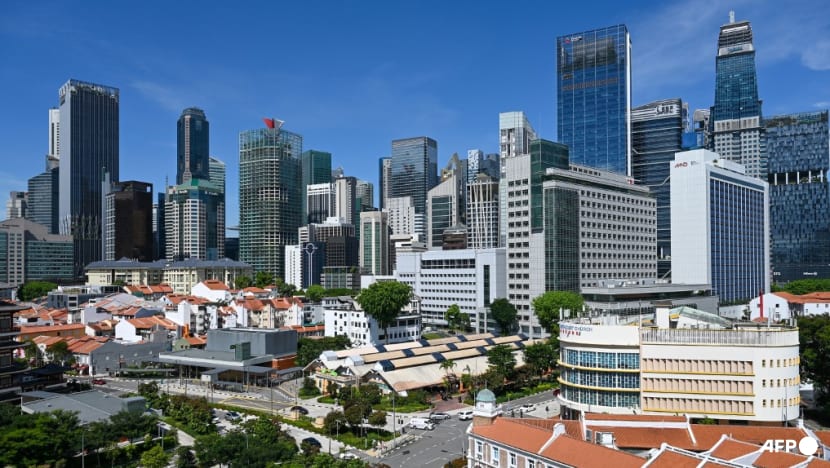Singapore to invest S$1m in research on how built environment affects mental health
At this year’s World Cities Summit, the Singapore Land Authority also announced a partnership with the Singapore Management University to tackle urban heat through map technology.

A general view shows the skyline of the central business district with the Chinatown and Maxwell areas in the foreground in Singapore on Apr 29, 2024. (Photo: AFP/Roslan Rahman)

This audio is generated by an AI tool.
SINGAPORE: How much can someone’s mental well-being be affected by the built environment?
To find out, Singapore will embark on a three-year project that will help to shape how the city-state is planned and make it healthier and more liveable.
This builds on current research that has primarily focused on how the built environment affects physical health, as well as the benefits of greenery on mental well-being.
The government will invest S$1 million (US$742,820) in the project which will be led by researchers from the Agency for Science, Technology and Research (A*STAR), announced Deputy Prime Minister Heng Swee Keat on Monday (Jun 3).
"The study will examine factors such as urban design features, density, human behaviours and mental well-being,” he said on the second day of this year’s World Cities Summit, held at the Suntec Singapore Convention and Exhibition Centre.
“The evidence-based insights gleaned from this study will serve to better inform the way we rejuvenate, reinvent and re-imagine our city-state,” Mr Heng added.
A*STAR researchers have proposed to develop a framework and an index of indicators to link the built environment to mental well-being.
The eventual findings can help city planners better understand and shape the city's future. It could also impact where facilities are located, land use configuration, and the intensity of a land development.
The research project was commissioned by the Urban Redevelopment Authority and the Housing and Development Board. It falls under the Research, Innovation and Enterprise 2025 Masterplan, to which the government committed S$28 billion in 2020.
On Tuesday, Mr Heng noted that cities must continuously evolve and develop “good hard infrastructure”. These include buildings, roads, ports, and airports to enhance connectivity and convenience.
“And equally, cities need soft infrastructure – for people to form social connections and build a sense of community and identity,” he added.
“Both these dimensions are vital in keeping cities buzzing, dynamic and cohesive.”
CITIES CAN GET PEOPLE AWAY FROM SCREENS
Mr Michael Leong, senior executive director of SAA Architects, a member company of the Surbana Jurong Group, noted that Singapore has still been able to cover about 40 per cent of its land with greenery despite limited land space and several competing needs.
“We have studies that are telling us that the presence of greenery in our physical environment - be it just being in a park, being in a garden, or even just looking at greenery - it does have health and well-being benefits to us,” he told Singapore Tonight.
“I think having that knowledge is very important because it takes a lot of time for us to create an environment that makes that possible,” he added.
In terms of a design element he would like to see, Mr Leong said that public spaces should allow communities to come together, especially in an intergenerational setting.
Mr Ben Channon, director of wellbeing consultancy Ekkist in the United Kingdom, said that people around the world are experiencing mental health crises linked to technology and information overload.
“We certainly see this as an opportunity for the built environment, because buildings and cities are an excellent way to get people away from their screens; get them engaging with the world around them,” he told Singapore Tonight.
The biggest challenge around this, Mr Channon pointed out, is getting leaders and governments to understand the link between buildings in cities and people’s health.
He equated spending on urban design to spending on healthcare, given how creating better places will result in better health outcomes for populations.
“Suddenly, it makes more sense to increase investment in housing and investment in cities, because governments will start to realise this will save the money in the long term in terms of reducing health care costs, reducing costs of caring for ageing populations,” Mr Channon added.
TACKLING URBAN HEAT
This year’s World Cities Summit also saw the signing of several memoranda of understanding, with the Singapore Land Authority (SLA) announcing one such collaboration with the Singapore Management University (SMU) to tackle urban heat by using map technology.
The government agency will share resources such as heat and street maps with SMU to address the problem.
The aim of the collaboration is for such maps to identify problem areas that generate intense heat. Analysing these trouble spots, which are surrounded by buildings and roads, could lead to better urban planning to mitigate rising temperatures.
Urban heating is partly why Singapore is warming up twice as fast compared with the rest of the world, at 0.25 degrees Celsius per decade, according to the country’s Meteorological Service.
Through its partnership with SMU, SLA also aims to groom talent in the field through student climate research projects.
Dr Orlando Woods, director of the SMU Urban Institute, said the collaboration will provide new data for researchers to better understand cities.
“What we're hoping to do with this, especially with the (geospatial) data that SLA can provide, is to add them to our existing models of cooling or heating in Singapore. And so the solutions that we propose can be even better; even more translational,” he added.




















